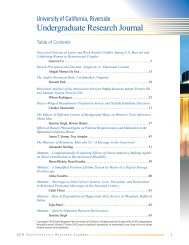2010 - Undergraduate Research, Scholarship and Creative Activity
2010 - Undergraduate Research, Scholarship and Creative Activity
2010 - Undergraduate Research, Scholarship and Creative Activity
You also want an ePaper? Increase the reach of your titles
YUMPU automatically turns print PDFs into web optimized ePapers that Google loves.
<strong>and</strong> music therapy, school <strong>and</strong> teacher support<br />
for grieving children, <strong>and</strong> other types of<br />
treatment for grief.<br />
Lead Regulation: Arresting the Painting<br />
P<strong>and</strong>emic<br />
Life Histories of Fish in the Subgenus<br />
Mollenesia<br />
Nicole Tarui, Biology<br />
Mentors: David Reznick , Mark Springer<br />
Department of Biology<br />
Suzy Taroyan, Political Science/Law <strong>and</strong><br />
Society<br />
Mentors: Carl Cranor<br />
Department of Philosophy<br />
Juliann E. Allison<br />
Department of Political Science<br />
Lead poisoning has become a global issue<br />
threatening the lives of innocent children <strong>and</strong><br />
adults even at relatively low amounts of<br />
exposure. Lead exposure can cause permanent<br />
damage by affecting every organ in the human<br />
body. This fatal exposure is occurring in<br />
developed countries <strong>and</strong> acutely occurring in<br />
developing countries due to the increased<br />
globalization of trade. Lead toxicity remains a<br />
major public health issue although its deadly<br />
consequences are entirely preventable. Lead<br />
poisoning occurs not only in the workplace but<br />
also in homes <strong>and</strong> in the natural environment.<br />
With this in mind I ask - what steps have the<br />
United States <strong>and</strong> other nations taken to prevent<br />
lead poisoning? What are the primary bases for<br />
the development <strong>and</strong> implementation of<br />
environmental laws in the United States as well<br />
as abroad? I draw on current research illustrating<br />
the harmful adverse affects of lead poisoning<br />
<strong>and</strong> preventative policies to propose that the<br />
only approach to reduce <strong>and</strong> eliminate lead<br />
toxicity is through international law. External<br />
pressures will oblige developing countries to<br />
enforce stringent regulations <strong>and</strong> bans which<br />
will ensure universal uniformity. I then conduct<br />
an extensive case study of China as well as subcase<br />
studies of India <strong>and</strong> Nigeria. I conclude that<br />
international laws <strong>and</strong> organizations such as the<br />
OECD Declaration on Lead Risk Reduction will<br />
compel developing countries to regulate lead by<br />
using sanctions <strong>and</strong> penalties. By strengthening<br />
<strong>and</strong> enforcing regulations in developing nations,<br />
exposure to lead will drastically decrease in the<br />
workplace <strong>and</strong> the environment, saving<br />
thous<strong>and</strong>s from premature death <strong>and</strong> permanent<br />
disabilities.<br />
As part of a comprehensive study of the<br />
evolution of the placenta in the livebearing fish<br />
family Poeciliidae, three of the four subgenera<br />
of the genus Poecilia, including Limia,<br />
Pamphoricthys <strong>and</strong> Micropoecilia have been<br />
observed in the lab to obtain life history data.<br />
This life history information that is collected<br />
includes age of maturation in both males <strong>and</strong><br />
females, the number of offspring produced, <strong>and</strong><br />
the intervals at which this occurs. These factors<br />
are all essential to characterize the life history<br />
<strong>and</strong> piece together the association between the<br />
evolution of the placenta <strong>and</strong> other features of<br />
the life history. The placenta is a multifaceted<br />
organ essential to the development of fetuses in<br />
some of these species. As in the other branches<br />
of the family Poeciliidae, the placenta has<br />
evolved within the genus Poecilia, in the<br />
subgenera Micropoecilia <strong>and</strong> Pamphorichthys.<br />
To complete this compilation of life histories to<br />
better underst<strong>and</strong> this evolutionary process, we<br />
have characterized the life histories of species in<br />
Mollienesia, the fourth subgenus of Poecilia.<br />
Using a common garden 5-gallon experiment,<br />
seven species of the subgenus Mollienesia will<br />
be observed to find detailed facts of their life<br />
histories. Detailing these patterns are all clues<br />
necessary in providing insight into the<br />
contributing factors of the evolution of life<br />
histories in this genus <strong>and</strong> the family<br />
Poeciliidae.<br />
Identifying Society's Vermin: Franz Kafka's<br />
Critique of Modernity in "The<br />
Metamorphosis"<br />
Adam Toth, Comparative Literature<br />
Mentor: Sabine Doran<br />
Department of Comparative Literature<br />
I want to examine Franz Kafka‘s ―The<br />
Metamorphosis‖ in its original German text to<br />
extrapolate exactly what it is Gregor Samsa<br />
transformed into. While Gregor Samsa may not<br />
Fourth Annual UCR Symposium for <strong>Undergraduate</strong> <strong>Research</strong>, <strong>Scholarship</strong> <strong>and</strong> <strong>Creative</strong> <strong>Activity</strong><br />
44














